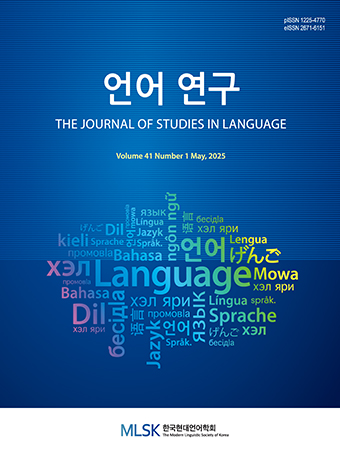Research Article
Abstract
References
Information
Since Firth (1957) and Sinclair (1991), it has long been assumed that speakers’ attitudes towards a word or a group of words in the actual utterance are decided by their collocates. Previous research on the semantic prosody has been conducted around semantically related words, making fine-grained meaning distinctions between the synonymous words. However, a few studies, if any, distinguish between words’ literal and metaphorical senses in defining their semantic prosodies. This paper focuses on whether there is any change in semantic prosody when the literal senses of words are extended to metaphorical ones. The result shows a change in semantic prosody especially when a word is not involved in a word group where positive, negative and neutral prosodies are assigned to their members.
- 정상원. 2020. 사물명칭의 환유적 확장 연구. 석사학위논문, 조선대학교 대학원.
- 최영주. 2020. 우산 의미에 대한 인지의미론적 접근. 담화와 인지, 27.3, 127-150. 10.31982/KNTS.2020.03.27.1.79
- Bednarek, M. 2008. Semantic Preference and Semantic Prosody Re-examined. Corpus Linguistics and Linguistic Theory 4.2, 119-139. 10.1515/CLLT.2008.006
- Bublitz, W. 1996. Semantic Prosody and Cohesive Company: ‘Somewhat Predictable’. Leuꠓvense Bijdragen 85.1-2, 1-32.
- Dam-Jensen, H. and Zethsen, K. K. 2008. Translator Awareness of Semantic Prosodies. International Journal of Translation Studies 20.2, 203-221. 10.1075/target.20.2.02dam
- Firth, J. R. 1957. Papers in linguistics 1934-51. Oxford: Oxford University Press.
- Gong, S.-P. and Wu, P.-Y. 2012. Collocation, Semantic Prosody, and Near-synonymy: The HELP Verbs in Mandarin Chinese. International Journal of Computer Processing of Language 24.1, 3-15. 10.1142/S1793840612400016
- Hoey, M. 2005. Lexical priming: A new theory of words and language. London, England: Routledge.
- Hunston, S. 2002. Corpora in applied linguistics. Cambridge: Cambridge University Press. 10.1017/CBO9781139524773
- Hunston, S. 2007. Semantic Prosody Revisited. International Journal of Corpus Linguistics 12.2, 249-268. 10.1075/ijcl.12.2.09hun
- Hunston, S. and Thompson, G. 2000. Evaluation in text: authorial stance and the construction of discourse. Oxford: Oxford University Press.
- Louw, B. 1993. Irony in the Text or Insincerity in the Writer? The Diagnostic Potential of Semantic Prosodies. In M. Baker, G. Francis and E. Tognini-Bonelli (eds.), Text and technology. Amsterdam and Philadelphia: John Benjamins, 157-176. 10.1075/z.64.11lou
- Louw, B. 2000. Contextual Prosodic Theory: Bringing Semantic Prosodies to Life. In C. Heffer and H. Sauntson (eds.), Words in context, A tribute to John Sinclair on his retirement. Birmingham: ELR, 48-94.
- Partington, A. 1998. Patterns and Meanings. Amsterdam: John Benjamins. 10.1075/scl.2
- Partington, A. 2004. Utterly Content in Each Other’s Company: Semantic Prosody and Semantic Preference. International Journal of Corpus Linguistics 9.1, 131-156. 10.1075/ijcl.9.1.07par
- Sinclair, J. 1991. Corpus, concordance, collocation. Oxford: Oxford University Press.
- Sinclair, J. M. 1996. The Search for Units of Meaning. Textus 9.1, 75-106.
- Smith, A. K. and Nordquist, D. 2012. A Critical and Historical Investigation into Semantic Prosody. Journal of Historical Pragmatics 13.2, 291-312. 10.1075/jhp.13.2.05smi
- Stubbs, M. 1995. Collocations and Semantic Profiles: On the Cause of the Trouble with Quantitative Studies. Functions of Language 2.1, 23-55. 10.1075/fol.2.1.03stu
- Stubbs, M. 2001. Words and phrases. Oxford: Blackwell.
- Tao, H. 2003. Toward an Emergent View of Lexical Semantics. Language and Linguistics 4.4, 837-856.
- Tognini-Bonelli, E. 2002. Functionally Complete Units of Meaning across English and Italian: Towards a Corpus-Driven Approach. In B. Altenberg and S. Granger (eds.), Lexis in contrast: Corpus-based approaches. Amsterdam: John Benjamins, 73-95. 10.1075/scl.7.07tog
- Wei, N. and Li, X. 2014. Exploring Semantic Preference and Semantic Prosody across English and Chinese: Their roles for cross-linguistic equivalence. Corpus Linguistics and Ling. Theory 10.1, 103-138. 10.1515/cllt-2013-0018
- Whitsitt, S. 2005. A Critique of the Concept of Semantic Prosody. International Journal of Corpus Linguistics 10.3, 283-305. 10.1075/ijcl.10.3.01whi
- Xiao, R. and McEnery, T. 2006. Collocation, Semantic prosody and Near Synonymy: A Cross-Linguistic Perspective. Applied Linguistic 27.1, 103-129. 10.1093/applin/ami045
- Publisher :The Modern Linguistic Society of Korea
- Publisher(Ko) :한국현대언어학회
- Journal Title :The Journal of Studies in Language
- Journal Title(Ko) :언어연구
- Volume : 38
- No :3
- Pages :291-305
- DOI :https://doi.org/10.18627/jslg.38.3.202211.291




 The Journal of Studies in Language
The Journal of Studies in Language






